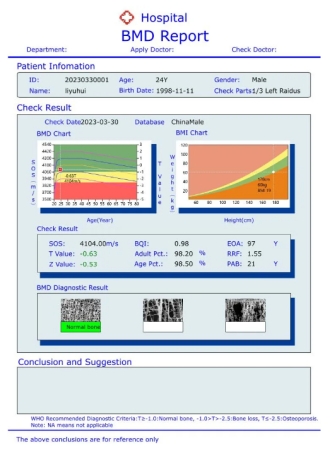Osteoporosis is a serious and common chronic disease that affects post-menopausal women and the elderly. Bone mineral density (BMD) is an important indicator for measuring bone strength and predicting the risk of bone fracture, and it is also a routine checkup for the elderly.
Not only patients, but also non-specialized doctors are often confused by the various indicators and data parameters on the BMD report form. In fact, it is not difficult to read the bone density report, the key is to figure out two values: T value and Z value. After reading and understanding the T-value and Z-value, you can basically determine whether you have osteoporosis and how serious the bone loss is.
As we all know, the bone density of a human being is constantly changing throughout his life, which can be roughly divided into three stages: from birth to youth, the bone density of the body gradually increases, which is in the “ascending stage”; at the age of 25-35 years old (average age of about 30 years old), the bone density of the body is at the highest peak of his life, i.e., the “plateau stage”; thereafter, with the growth of age, the loss of bone will be accelerated, and the bone density of the body begins to gradually decline.
Clinical significance of T-value
The so-called T-value is the standard deviation of the BMD of the examined person compared with the average value of the BMD of healthy young people of the same sex, and the standard deviation of the BMD of the young people is found to be higher than (indicated by + sign) or lower than (indicated by - sign) the young people, i.e., T-value = (BMD value of the examined person - average value of the young people's BMD)/standard deviation of the young people's BMD.
T-value is a relative value, reflecting the difference in bone mineral density (BMD) between the subject and young people, and the T-value is usually used in clinical practice to determine whether the body's bone mineral density (BMD) is normal or not, and it is also the most meaningful indicator for diagnosing primary osteoporosis.
Judgment criteria:
-1 < T value < 1 means normal BMD value;
-2.5 < T value < -1 indicates a decrease in bone mass, indicating bone loss;
T value <-2.5 indicates osteoporosis;
T-value <-2.5 with one or more fractures indicates severe osteoporosis.
Note: T-value is only applicable to diagnose primary osteoporosis (mainly refers to postmenopausal and senile osteoporosis), but cannot be used to diagnose osteoporosis in children, premenopausal women and men <50 years old.
Clinical significance of Z-value
The so-called Z value is to compare the BMD of the subject with the average value of BMD of normal people of the same gender and age, i.e., Z value = (BMD value of the subject - average value of BMD of the same age group) / standard deviation of BMD of the same age group.
The Z-value reflects the difference in bone mineral density (BMD) between the subject and a normal person of the same age. For example, if the subject is 30 years old, the Z-value is compared to the average BMD value of a normal 30 year old, and a positive or negative Z-value indicates a higher or lower BMD than that of a healthy person of the same age. z-value, like the T-value, is a relative value expressed as a standard deviation (SD).
Judgment Criteria:
Z value > -2 means that the bone density of the examinee is within the normal range of the same age group; Z value < -2 means that the bone density of the examinee is lower than the normal range of the same age group, and the possibility of osteoporosis is higher;
Note: A normal Z-value does not mean that there is no problem at all with bone density. For example, a normal Z-value in an elderly person does not necessarily mean that he/she does not have osteoporosis or that he/she has a low risk of fracture.
This is because even normal elderly people in the same age group also have bone loss, bone density reduction and bone fragility increase associated with aging. In this case, obviously, the Z value can not be used to judge whether there is osteoporosis or not, but should refer to the T value to accurately judge the patient's bone density.
In other words, although the Z value can reflect the severity of osteoporosis, it is of little significance in the diagnosis of senile osteoporosis and is mainly used in the diagnosis of osteoporosis in children.
Post time: Aug-16-2024

